
William Kent was an English architect, landscape architect, painter and furniture designer of the early 18th century. He began his career as a painter, and became Principal Painter in Ordinary or court painter, but his real talent was for design in various media.

Lyme Park is a large estate south of Disley, Cheshire, England, managed by the National Trust and consisting of a mansion house surrounded by formal gardens and a deer park in the Peak District National Park. The house is the largest in Cheshire, and is recorded in the National Heritage List for England as a designated Grade I listed building.

Sir James Thornhill was an English painter of historical subjects working in the Italian baroque tradition. He was responsible for some large-scale schemes of murals, including the "Painted Hall" at the Royal Hospital, Greenwich, the paintings on the inside of the dome of St Paul's Cathedral, and works at Chatsworth House and Wimpole Hall.
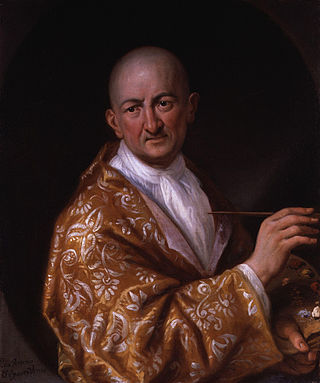
Antonio Verrio was an Italian painter. He was responsible for introducing Baroque mural painting into England and served the Crown over a thirty-year period.
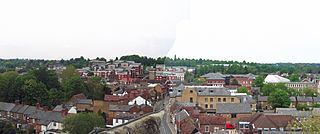
Rickmansworth, is a town in south-west Hertfordshire, England; it is located about 17 miles (27 km) north-west of central London, 5 miles (8 km) south-west of Watford and is inside the perimeter of the M25 motorway. The town is mainly to the north of the Grand Union Canal and the River Colne.

Giacomo Leoni, also known as James Leoni, was an Italian architect, born in Venice. He was a devotee of the work of Florentine Renaissance architect Leon Battista Alberti, who had also been an inspiration for Andrea Palladio. Leoni thus served as a prominent exponent of Palladianism in English architecture, beginning in earnest around 1720. Also loosely referred to as Georgian, this style is rooted in Italian Renaissance architecture.

Eaton Hall is the country house of the Duke of Westminster. It is 1 mile (2 km) south of the village of Eccleston, in Cheshire, England. The house is surrounded by its own formal gardens, parkland, farmland and woodland. The estate covers about 10,872 acres (4,400 ha).
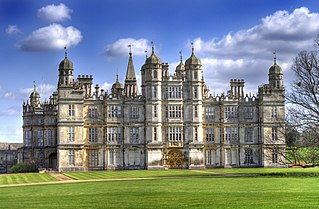
Burghley House is a grand sixteenth-century English country house near Stamford, Lincolnshire. It is a leading example of the Elizabethan prodigy house, built and still lived in by the Cecil family and is Grade I listed.
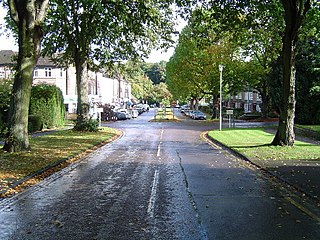
Moor Park is a private residential estate in the Three Rivers District of Hertfordshire, England. Located approximately 16 miles (26 km) northwest of central London and adjacent to the Greater London boundary.
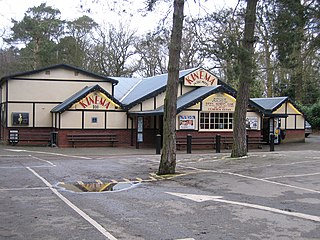
Woodhall Spa is a former spa town and civil parish in the East Lindsey district of Lincolnshire, England, on the southern edge of the Lincolnshire Wolds, 6 miles (10 km) south-west of Horncastle, 23 miles (37 km) west of Skegness, 15 miles (24 km) east-south-east of Lincoln and 17 miles (27 km) north-west of Boston. It is noted for its mineral springs, historic cinema and its Second World War association with the RAF 617 Squadron, commonly referred to as 'The Dambusters'.

Matthew Brettingham, sometimes called Matthew Brettingham the Elder, was an 18th-century Englishman who rose from modest origins to supervise the construction of Holkham Hall, and become one of the best-known architects of his generation. Much of his principal work has since been demolished, particularly his work in London, where he revolutionised the design of the grand townhouse. As a result, he is often overlooked today, remembered principally for his Palladian remodelling of numerous country houses, many of them situated in the East Anglia area of Britain. As Brettingham neared the pinnacle of his career, Palladianism began to fall out of fashion and neoclassicism was introduced, championed by the young Robert Adam.
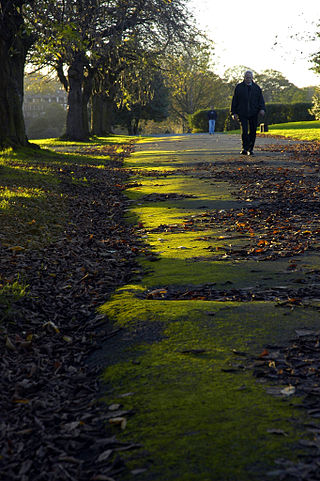
Armley Park is a large public park located next to Stanningley Road in Armley, on the outskirts of Leeds, in West Yorkshire, Northern England.

Bramham Park is a Grade I listed 18th-century country house in Bramham, between Leeds and Wetherby, in West Yorkshire, England.

Belhus is a golf course, country park, former stately home and manor in the parish of Aveley in Essex, England. The historic manor was known in medieval times variously as "Bellhouse, Belhouse, Bell House", etc. It is now part of the Thames Chase woodland planned for the area.

Thorndon Hall is a Georgian Palladian country house within Thorndon Park, Ingrave, Essex, England, approximately two miles south of Brentwood and 25 miles (40 km) from central London.
Francesco Sleter was an Italian painter, active in England.
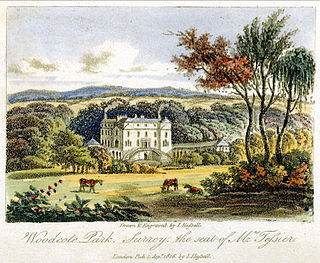
Woodcote Park is a Grade II* listed stately home and estate of about 350 acres near Epsom, Surrey, England, currently owned by the Royal Automobile Club. It was formerly the seat of a number of prominent English families, including the Calvert family, Barons Baltimore and Lords Proprietor of the colony of Maryland. The interior of the house once boasted a gilded library and number of fine murals by notable Italian artists including Antonio Verrio, but most of the historic rooms were removed by the RAC, which had purchased the estate in 1913, and what remained was destroyed by fire in 1934. The present appearance of the house dates from its restoration in 1936. However, the interior of one of the original drawing rooms still survives in the Museum of Fine Arts at Boston, Massachusetts. The estate was used by the military as a convalescent hospital in the First World War and as a training camp in both world wars.

Benjamin Haskins-Stiles, of Bowden Park, near Chippenham, Wiltshire and Moor Park, Hertfordshire, was an English landowner and politician who sat in the House of Commons from 1721 to 1734.

Wall Hall, originally known as Aldenham Abbey, is a country house at Aldenham in Hertfordshire, England. The main house and several ancillary buildings are Grade II listed. The gardens and parkland are also on the Register of Historic Parks and Gardens of Special Historic Interest in England.

Burton Park is a 19th-century country house in the civil parish of Duncton in West Sussex, and is situated 1/2 a mile to the east of the village of Duncton, within its own estate. It is a Grade I listed building, now converted into multiple occupation.




















